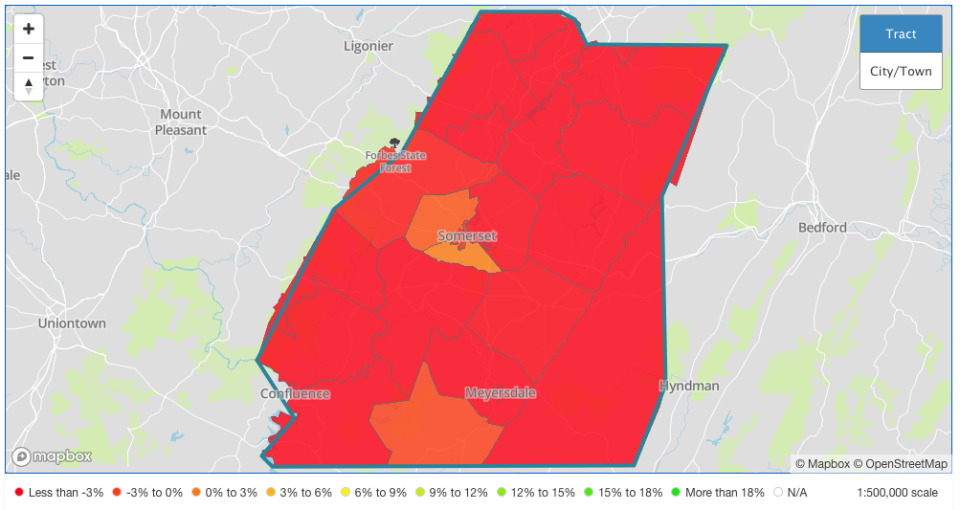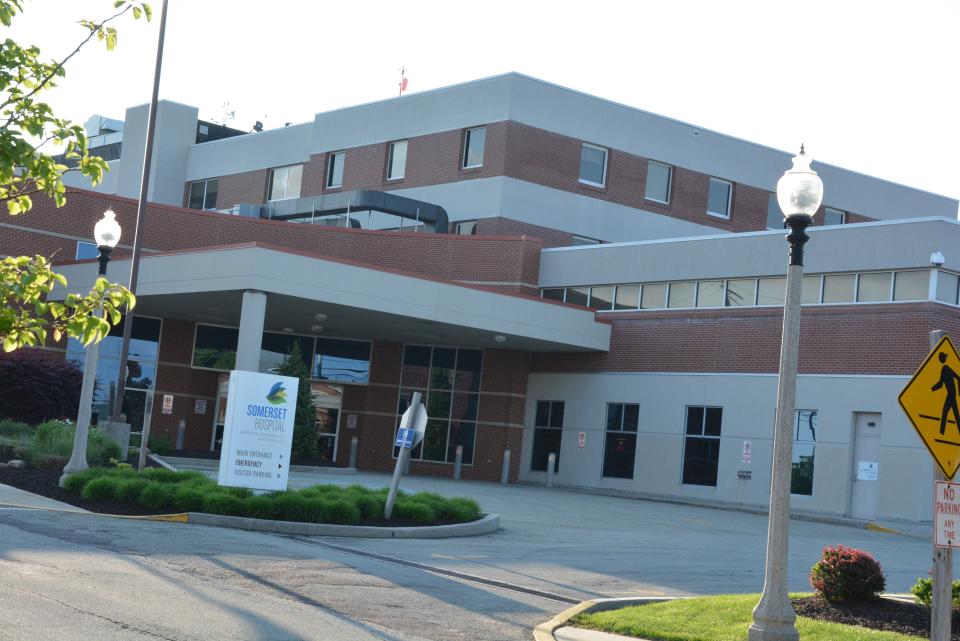Report indicates Somerset County population will drop by 8,000 by 2050
Somerset County may lose more than 8,000 members of its population by 2050.
The Center for Rural Pennsylvania, in partnership with the Pennsylvania State Data Center, in October released projected population changes by county, through the year 2050. The data shows a continuing change in direction in Pennsylvania’s rural and urban counties, with urban areas projected to grow 4.1%, while rural areas face a 5.8% decline.

The decrease in population may affect a wide range of policy issues, including workforce needs and trends, housing, health care, education, transportation, and more. These projections also suggest a significant aging of the population.
Somerset County's population in April 1, 2020, was 74,016. The population projection for 2050 is 65,754, a percentage change between 2020-2050, of -11.2%.
Pennsylvania’s population is expected to increase in 2030 and 2040, but will experience a slight decline by 2050, the report shows. This leads to an estimated 30-year growth rate of 1.6%. By comparison, the state’s overall population grew at a rate of 2.4% between 2010 and 2020.
Rural counties on the decline
The population of rural counties is projected to decline by 5.8% over the next 30 years. Rural counties overall experienced a decline from 2010-20. Projected population totals suggest this trend will continue over the next 30 years, with the population in rural counties declining by 5.8% between 2020 and 2050. Urban counties are projected to continue growing but at a slow pace. Between 2020 and 2050, the total urban population is expected to grow by 4.1%.
Population ages
The aging of the Baby Boomer generation will significantly affect the state's available workforce over the next decade, especially in rural counties with high senior citizen populations. One of the most significant changes driving estimated populations is the increasing age of the population over the next 30 years.
As the Baby Boomer generation continues to retire and age, the population of residents older than 65 is going to increase. This trend, contrasted with a declining statewide birth rate, means that rural Pennsylvanians over the age of 65 will soon outnumber those under 20.
What does that mean for the workforce and economic planning, as governments and the private sector adapt to supporting more retired and elderly residents with a smaller workforce? Pennsylvania’s retirement-age population will peak in 2035, suggesting that economic adjustments to support the aging population may require quick action.
This change will undoubtedly affect a wide range of policies across the Commonwealth, including, but not limited to, housing, health care, education and transportation.
Dependency ratio
The dependency ratio is a measure of workforce stability and care needs for an area, by comparing the number of retirement-age residents and youth with the number of working-age residents. The higher the number, the more financial stress on the labor of working-age residents.
Since 1990, the dependency ratio has been relatively consistent between urban and rural counties, though urban counties tend to maintain a lower ratio because of the larger number of working-age adults.
The population projections suggest that as Baby Boomers continue to age, the lack of working-age adults in rural counties will cause the rural dependency ratio to increase. This may mean the workforce needs for senior care in rural counties could be significant over the next decade.
Region coming up with solutions
The Southern Alleghenies Planning Region includes the counties of Somerset, Bedford, Blair, Cambria, Fulton and Huntingdon in southwestern Pennsylvania. Alleghenies Ahead is the region’s six-county comprehensive plan, a collaborative effort to implement strategies that will boost the region’s ability to create and compete for jobs, attract and retain residents, and become a place with stronger and more vital communities.
What requires focused attention to overcome demographic disadvantages and capacity limitations is one segment of the commission's comprehensive plan. Southern Alleghenies has formed a steering committee in each of the six counties to identify priorities and come up with detailed plans on how to move forward. Now there is a committee striving to come up with solutions on how to deal with the predicted population decline.
County coming up with a plan
Somerset County officials are seeing this drop in population for their businesses and organizations and say they are doing the best that they can to adjust to the population decline and still offer quality service.
Education
Somerset County schools have been showing a steady decline since the 2008-09 school year. The Somerset Area School District shows a loss of 540 students, Rockwood 249 and Turkeyfoot 148 students up to the 2023-24 school year. Mark Bower, superintendent of the Rockwood Area School District, said most districts are facing similar challenges.
"We work very closely together to meet the needs of our students," he said in an email. "The decline in enrollment has made it more difficult to maintain all of our academic, co-curricular, and extracurricular activities. In some cases, we just don't have enough students to sustain individual programs in our schools. It has become commonplace for schools in our area to share athletic programs to continue to offer athletic opportunities for our students. Districts in the county are now starting to share teachers in subjects that are either difficult to find certified teachers for, or because there is not a need for a full-time teacher in some subject areas."
Should the schools consider merging to be able to continue educating the students?
"The geography of Somerset County is just one challenge facing the merger of school districts, while differences in policies, procedures, and the current state of financial positions and resources present other challenges for merging districts," Bower said. "One major challenge facing mergers is the growth of cyber-charter schools. Families whose children would likely experience long bus rides if schools were to merge may opt for enrolling their children in cyber-schools. Any possible financial savings for districts would likely be eaten up by tuition payments to the cyber-charter schools."
Bower said many districts in the area are now participating in a cooperative academic program sponsored by Intermediate Unit 8 called Extended Campus. Extended Campus is a distance-learning platform offering curricular programs to students that would not otherwise be available in most of the small districts in this region, he said.

Health care
Andy Rush, president of UPMC Somerset, said over the last several years, a decline in the population of Somerset County, as well as an increase in the population over the age of 65 that is expected to continue, is one of the reasons that creating and improving access to high-quality health care in the community is among the hospital's top priorities.
"We know as people get older, their ability to travel becomes increasingly difficult. It is so important that our patients can see their doctors without needing to drive outside of the region. We know that as people age, they need to need these specialties more frequently," he said in an email. "We are continuously working on recruiting new doctors to Somerset and looking for opportunities to expand services, especially with a focus on cardiology, gastroenterology, general surgery, gynecology, primary care and surgical spine care."
Rush said telemedicine is especially important in rural communities.
"With telemedicine in the inpatient setting, we can treat patients in Somerset that would have previously needed to be transferred to a higher acuity hospital," he said. "We are also thrilled to be able to offer an outpatient telemedicine center in which patients come to an office in Somerset that is equipped with technology to connect to sub-specialty care. Patients don’t need to be technologically advanced to be able to access the service, as they meet with a health care professional in the office that connects them with the specialist."
In the coming months, the Daily American will further explore the potential consequences of and solutions to population trends in Somerset County across multiple sectors – including what policymakers, stakeholders and others are doing to address them.
This article originally appeared on The Daily American: Report: Somerset County facing 8,000 population loss by 2050

